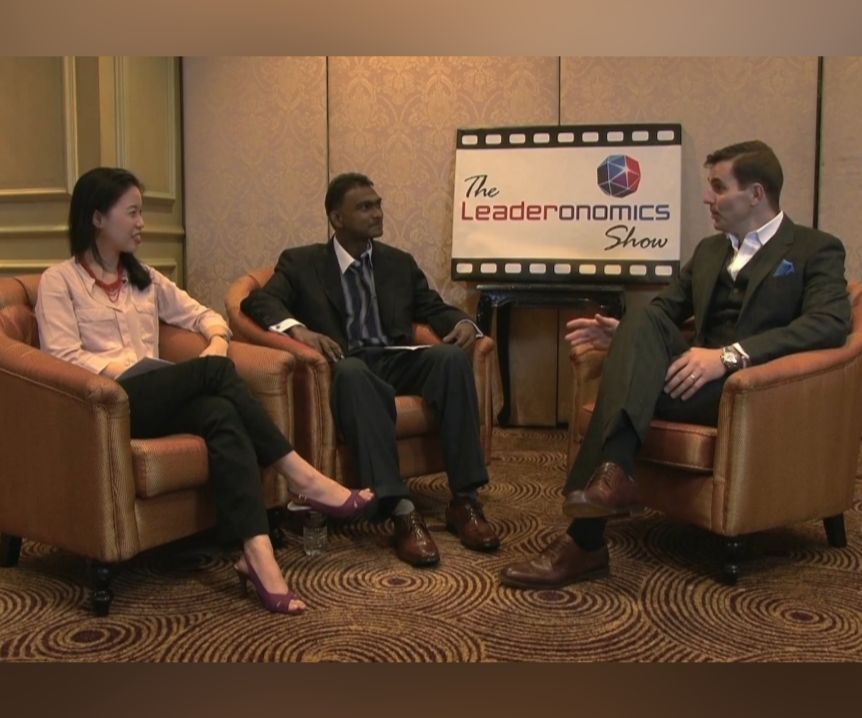Don't Chase KPIs, Create Momentum: The Initial Push

Rawpixel.com from Freepik
This is the first in a three-part article series on leadership, culture, and creating momentum. Whether you're leading a team of two or an organisation of two thousand, the principles in this series are about what truly moves people and organisations forward.
In Part 1, we lay the foundation: why momentum matters more than KPIs, how it begins with vision, and what leaders must do in the earliest stages to create movement.
In Part 2, we’ll shift the focus to people—what great leaders actually do to earn trust, drive alignment, and build unstoppable energy in their teams.
In Part 3, we close the loop by talking about sustainability: what it takes to maintain momentum, protect the culture, and keep the flywheel spinning long after the leader steps out of the spotlight.
It took me years into my career to understand what the point of being a leader was. It’s about building momentum.
What is momentum? Craig Groeschel, host of the Craig Groeschel Leadership Podcast defines it this way, “Momentum is the force that propels your organisation forward and is greater than the sum of all your leadership, strategy and resources combined.”
It is movement. And it stems first from vision. Without vision, there won’t be momentum. Without momentum, the vision will not materialise.
Every KPI seeks to create some form of momentum. The same for every annual business planning session, core values integration program, bonus scheme, L&D program, strategy and implementation workshop, culture immersion onboarding for employees, etc.
You can hit every target and still lose the war. Why?
Because KPIs don’t move people. Momentum does.
I’ve seen it in teams, in turnarounds, in seasons of acceleration — and when things stall.
Every CEO seeks to create momentum, knowingly or not. It is the CEO’s greatest ally. An organisation without the right momentum is a leader’s toughest battle.
With it, things start to move on their own.
1. Moving the Boulder
Whether you are CEO or an assistant manager without any direct reports, this applies to you. Being an intentional leader means that you innately take complete ownership and accountability of moving your area of responsibility forward. To move the needle, as I would always remind my team. There’s no such thing as “business as usual” and keeping the status quo.
A leader’s role is to carry the mindset of moving the needle for the organisation and ensuring tangible noticeable positive differences are seen and felt where they have immediate influence. This mental state positions you into a starting position to move in the right direction. It is the start of creating momentum and the energy originates from you. The leader of the unit.
Energy is in constant movement. Recognize that you can create energy from within and leverage external influences to generate inspiration and emotions with your team to replicate positive energy. Momentum can only happen when you win people over towards the vision. If you’re not CEO, as many aren’t, it is about winning your team and/or your stakeholders, be in other colleagues, towards your interpretation of the greater organisation vision for your area of responsibility.
It is not easy though. Creating momentum is like moving a giant boulder uphill. It is all resistance at the beginning. It is heavy. It is lonely. It is thankless. Worst of all, you look stupid trying to move a giant boulder uphill, as it is with creating momentum in the organisation.
It is not possible to create and then build-up momentum by yourself. You need a few core champions onboard the bus of momentum for some movement to happen. These are the ones who believe in you enough to stay close even when things look ridiculous, when the vision sounds too big, or when the rest of the organisation is watching from the sidelines. These champions are rarely the loudest. Often, they’re the steady, loyal, and brave ones who are willing to try with you.
Make your team thrive: 8 Elements of Effective Employee Engagement
At the beginning, it feels like one step forward, two steps back. You’ll get derailed. Firefighting will happen. People will laugh. Some will mock the effort. But this is the hardest and most important part of building momentum — to keep going despite the ridicule, the silence, the slow progress. To keep showing up with conviction, belief, and relentless consistency.
Find your quick wins. They don’t have to be big milestones but small ones that are quick and achievable for the key people in your bandwagon to feel a sense of accomplishment. This is important, not so much for the task itself but the buy-in and emotional triumph you want to create to influence more core champions. It is a “recruitment strategy” to convert the naysayers. Do it quick to build your credibility, confidence in your vision and to change the “language” that it cannot be done to one of belief.
I remember when I joined an organisation with the mandate to reverse a declining revenue trend and strengthen the brand image of the company. It would be a monumental 3-year transformation plan, in my estimation then but I needed my stakeholders across other departments to look at the plan positively and quickly. A small, quick win but significant one was to secure an outdoor “Spectacular” billboard that carried only one simple headline for the brand to stamp its market leadership position. It was a significant small win that immediately won the hearts of the stakeholders because it reminded them of the pride in working for the brand and company again. Once a small and quick win is accomplished, I did not hesitate to inform the entire organisation about it, attributing it to the transformation plan and the team that made it happen. We converted some naysayers that day.
Small and frequent quick wins are essential to create momentum because little by little, it compounds over time to create a powerful and simple impression to the rest of the organisation - the vision is working and it feels good to be on a winning team, so join us. Slowly, you start to win people over. One becomes two. Two becomes five. Then ten. The resistance doesn’t vanish, but it shifts.
Efforts begin to compound. Belief spreads. And you hit what Malcolm Gladwell refers to as the tipping point. That moment when the boulder begins to roll — not because you’re pushing harder — but because gravity has finally joined the effort.
Momentum, once created, takes on a life of its own. But it’s fragile. Distractions, internal politics, toxic people — these are the true killers of momentum. Not competitors. Not market shifts.
2. Vision Doesn’t Move People — Until It Gets Personal
Yes, KPIs matter. They help us measure progress. But they are not what drives people to give their best. KPIs might change behavior momentarily, but they don’t sustain belief. And without belief, there’s no buy-in, energy, nor momentum.
We lose the plot when we obsess over targets without asking the deeper question: Why should my team care about this? If people don’t understand how the KPI connects to something meaningful — something that matters to them — it becomes another task on the list. A number to hit. A box to tick, without ownership or drive.
Start by asking what success actually looks and feels like for your people. What would make them feel proud? What kind of recognition would resonate? What rewards would energise and excite them?

Source: Freepik
That’s the carrot. That’s what gets people moving. The KPI only becomes relevant once the carrot is visible and desirable to the individual.
And for that to happen, leaders need to create an environment — an ecosystem — where everything connects: the vision, the KPIs, the rewards, the feedback, and the personal meaning. It’s not one element in isolation. It’s all of them working together to create movement in the right direction.
But here’s where it is often overlooked.
When a company is going through a change or facing a turnaround, the reflex is to gather everyone for a planning retreat. Come up with a new vision statement. Craft a bold BHAG. Brainstorm initiatives. Draw out timelines and task lists.
There’s value in these sessions. They can set the tone and send a signal that a new direction is needed. But the real work doesn’t begin or end in a meeting room. A vision on a wall or in a slide deck doesn’t build momentum.
It’s what happens after the retreat — when people go back to their desks, their teams, their daily grind that matters most. That’s where alignment either happens or doesn’t. Too often, teams leave with a list of action items but without the emotional connection to the vision behind it. Without personal relevance, momentum fizzles out. Vision gets buried under the weight of operations. People forget the “why” and only remember the “what.”
Live your values: How Great Leaders Bring Core Values to Life
Because here’s the truth:
Vision cannot be executed through checklists.
It has to mean something to the people who are tasked to bring it to life.
A great vision is aspirational, inspirational, and deeply emotional. It paints a picture of success that’s worth striving for. But more than that, it allows each individual to see themselves in that picture.
That’s when it becomes personal.
They start to believe that their own growth, their family’s future, their values — can find a place in that vision. Because when you’re asking someone to go on a journey with you, you’re not just inviting them — you’re inviting their families, their hopes, their futures to hitch their wagon to yours.
You’re not just leading people. You’re leading lives.
And that’s why emotional resonance matters. That’s why momentum only comes when people feel something about where they’re going and who they’re going with.
When people remember how you made them feel — valued, included, part of something greater — they will go the distance for you. They will endure the grind, face the resistance, push through the unknowns.
So, if the KPI is the measure of success, then emotional buy-in is the fuel that gets us there.
Leaders who understand this spend more time building connection before chasing completion. They speak to hearts before asking for hands. Because once your people believe in the vision — once it becomes their vision too — you don’t have to push.
They’ll move.
And that’s when real momentum begins.
What’s Next in Part 2:
Where Part 1 examined how momentum begins, Part 2 shifts the focus to people.
We’ll explore:
• Why being both respected and liked matters more than many leaders realise
• What research tells us about relational credibility in leadership
• How trust and alignment are built through conversations, not policies
• And how the first signs of real momentum begin to take root in teams.
This article was firstly published on Ben Foo's LinkedIn.
Join us at the Malaysia Leadership Summit 2025 and discover the latest AI insights transformative success!
Edited by: Anggie Rachmadevi
Leadership
Tags: Vision, Be A Leader, Consultant Corner, Engagement, Growth
CEO & Growth Architect with 27+ years of leading business transformations, scaling profitability, and executing high-impact strategies across F&B, Retail, Higher Education, and Corporate Travel. Proven success in revenue growth, P&L turnaround, and operational excellence at global and regional scales.






